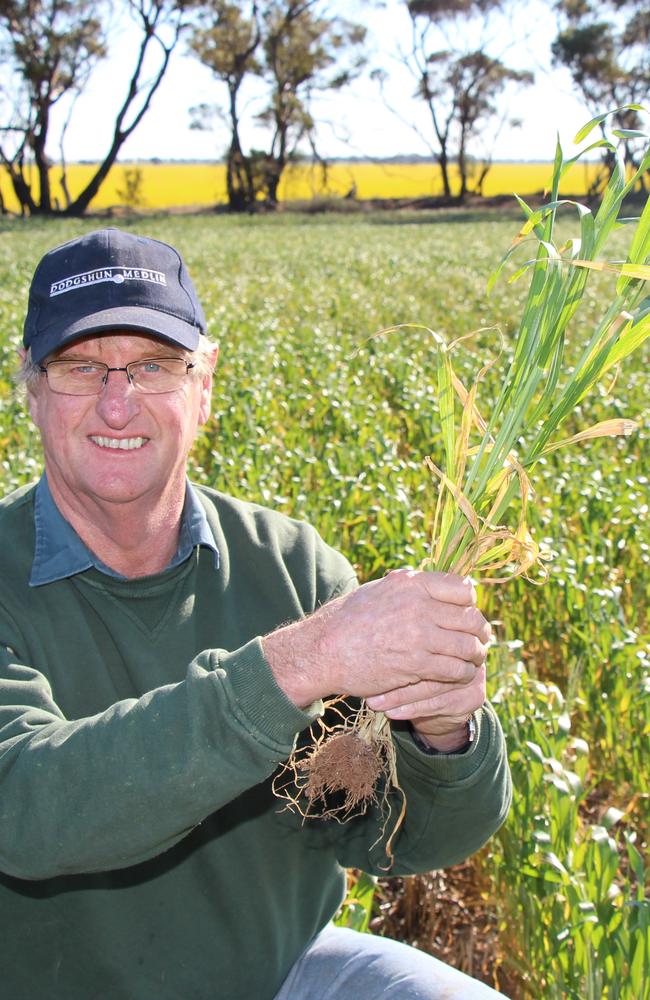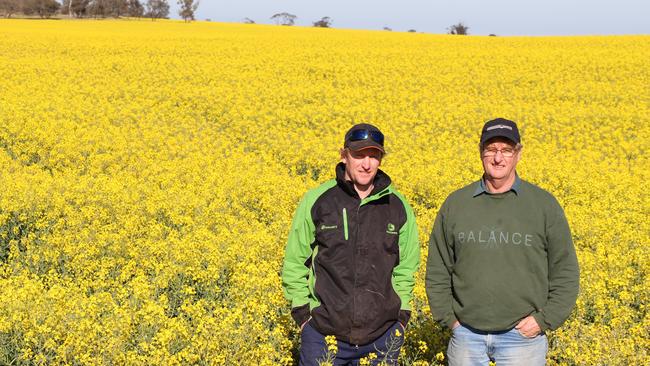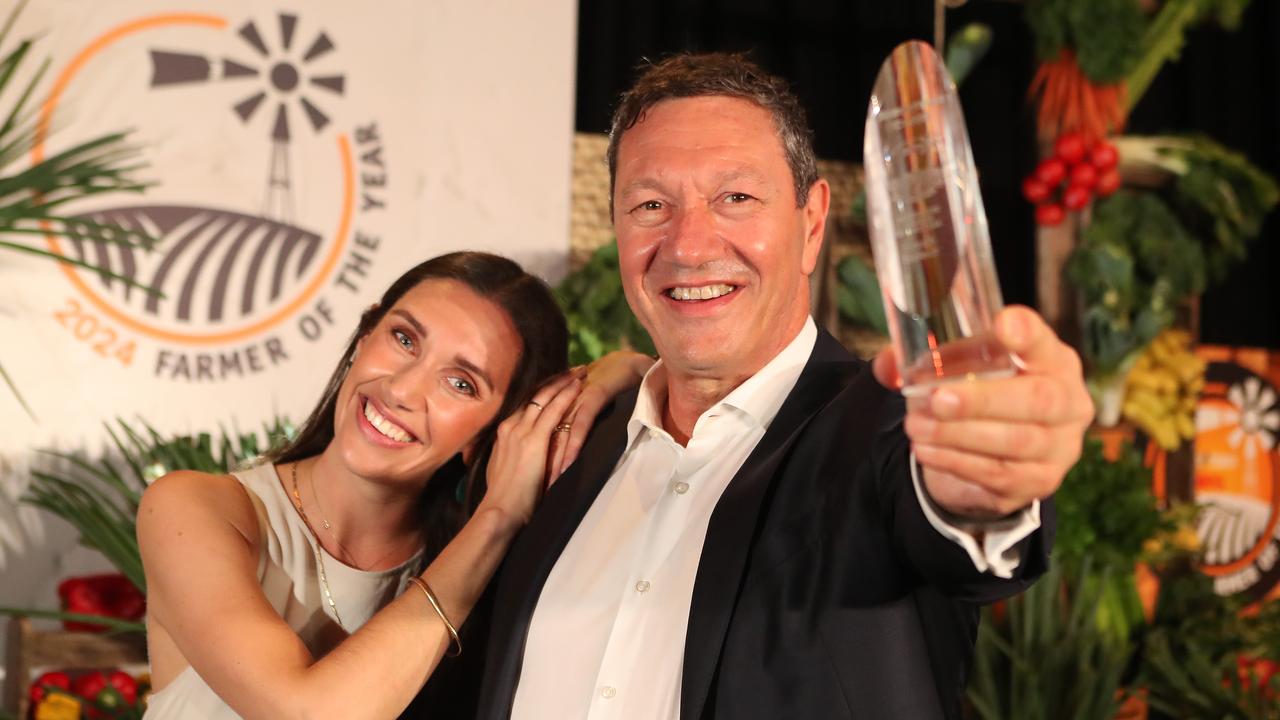Bibbys of Berriwillock using science and technology in cropping
THE Bibby family of Berriwillock uses science and technology to serve up its fair share of aces, writes EMMA FIELD.

WHEN Garry Bibby was a student more than 40 years ago, he had no idea the impact plant science and technology would have on his family farm.
In the past decade, his cropping and cattle operation at Berriwillock, in Victoria’s Mallee, has changed to a no till, high technology, precision agricultural business that this year planted 5000ha of crops.
Garry runs the business with wife Kate, sons Karl and Anthony, Anthony’s wife, Rachel, and three full-time employees.
After taking on an additional 1200ha in 2012, they this year planted 1244ha of grenade and scout wheat, 1648ha of scope and hindmarsh barley plus some feed barley, and 557 ha of triazine-tolerant and Clearfield canola.
About 28 per cent of their crops are legumes, which this year include 759ha of lentils (their most profitable crop last year), 165ha of chick peas, 170ha of field peas and 287ha of vetch for hay.
Garry introduced vetch 20 years ago, when many considered it a weed.
“It was popular in South Australia so I got some seed ... I saw its potential, it was good livestock feed and nitrogen fixing,” he said.
“It was versatile and my adviser saw the benefits, he recommended it to his clients and I sold some of my seed to them, and it took off.”
It wasn’t the only change Garry introduced after he returned to his parents’ property in the 1970s, clasping a degree in zoology and botany, with a major in plant physiology.

Fifteen years ago they sold off their sheep, retaining the cattle that Garry says help graze out weeds and vetch, and make use of stubble.
A decade ago they switched to no till and direct drilling, originally using a Horwood Bagshaw Scaribar with 30cm spacing and press wheels.
“I could see the benefits of conserving moisture and helping control resistant weeds, which were getting out of control,” Garry said. “With direct drilling we were able to get on top of resistant ryegrass.”
A decision to increase their operation and leasing 1200ha meant a major equipment upgrade, including a seeder bar, header and self-propelled sprayer. The new 18m Bourgault 3320 seeder bar came with 38cm row spacing.
“It’s easy to adjust the depth of seeding and it’s pressure-controlled from the cabin on each tine and press wheel,” Garry said. “There is no sign of wheel tracks and results in very even germination. This year we had to keep chasing the moisture, as we are in a dry environment.”
THEM’S THE BREAK
THE BIBBYS normally dry sow cereal crops before Anzac Day, but this year’s early break saw them sow into moisture.
Vetch, canola and lentils are sown in mid-April.
“We do not like germination of wheat and barley before Anzac Day, and peas are sown last in the first week of May,” Garry said.
This year’s cropping has proved challenging with an excellent start in autumn, but early frosts in July which caused some damage, and a dry winter.
According to the Bureau of Meteorology, Berriwillock received 2.6mm in August and 50mm for winter after 115mm in autumn.
“We had no summer rain this year, so no subsoil moisture, we are predicting yields will be reduced by about one third to half of our average,” Garry said.
“We are predicting yields will be reduced by about one third to half of our average.”
In a good year, barley yields average 2.4 tonnes/ha and wheat 2.5 tonnes/ha.
Three years ago the Bibbys introduced variable rate application for seed and fertiliser.
Using John Deere farm management software Apex, they develop prescription maps based on soil types and previous cropping yields, from GPS information on the farm.
“The main thing we used variable rates for is for urea (application) ... we are using the same amount of nitrogen, but it’s better targeted,” Garry said.
Another innovation this year was testing paddocks for ryegrass resistance, a problem first noticed about 12 years ago.
“This year we tested four paddocks, the paddocks with legumes and lighter soil had major resistance,” Garry said. “We found (pre-emergent herbicide) trifluralin had a much better impact on rye-grass than we thought.”

The Bibbys have also used other strategies for controlling rest weeds, including crop rotations, the use of Clearfield varieties and getting good advice on chemical group rotations. Garry said independent agronomic advice from Dodgshun Medlin, which facilitates group learning from clients, was critical to their operation.
They have also had issues controlling brome grass, and planted Clearfield wheat grenade to assist with this, as well as hurricane lentils, which tolerate Clearfield herbicide residual.
And at harvest a spray bar is fitted to the windrower to spray weeds in canola.
STORAGE KING
THE Bibbys have only enough on-farm storage to hold their seed at harvest, opting to become a shareholder in the Berriwillock Grain Co-operative, which built a storage facility in 2008, for up to 115,000 tonnes.
Garry said the $20,000 shareholder investment provided a better return than building their own storage and ongoing associated costs.
“I can store my entire harvest there, and its weighed and tested on site,” he said.
The Bibbys have started harvesting barley, canola and peas, and expect to finish in early December. Most of their barley is yielding 1 tonne/ha with quality described as good.
Garry said they would sell most of their grain during harvest and to assist with marketing they used a broker to find the best prices.
“If you don’t have time to be ringing around for prices, then I think using a broker is a good idea.” he said.


